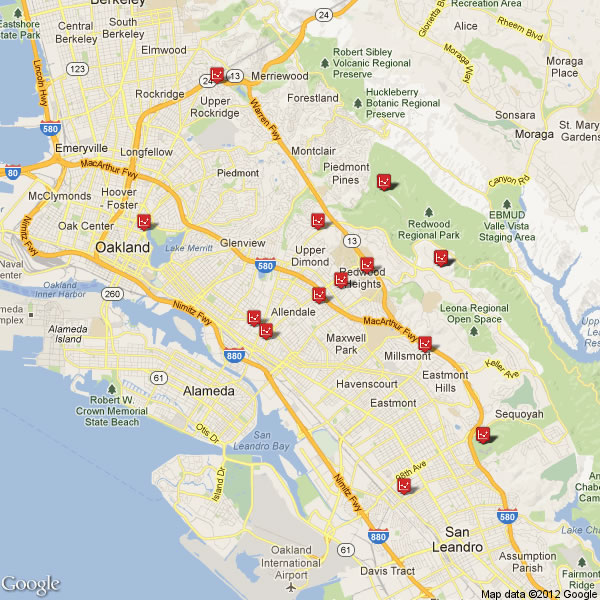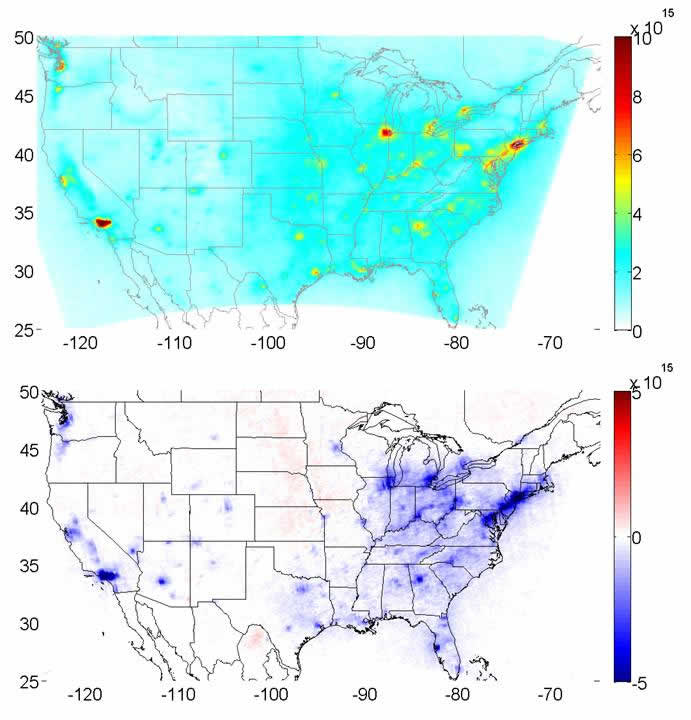The chemical composition of the atmosphere over a city, often referred to as the “urban dome,” can provide insight into how that city consumes energy and resources. Specifically, changes in composition across space and/or time allow us to pick out specific sources and, for example, determine where regulations will be most effective in reducing pollution, or predict when air quality alerts should be issued. We study CO2 emission and transport within a city as well as long-term trends in nitrogen oxide (NOx) concentrations.
CO2
CO2, a greenhouse gas, is of immense interest to atmospheric and earth systems scientists as it is emitted largely by anthropogenic sources (specifically through energy consumption). Despite its incredible importance, CO2 is measured primarily on regional or global scales using highly precise instruments, and research has focused on the global background; highly spatially-resolved measurements are not available from these instruments due to their great expense. The Berkeley Atmospheric CO2 Observation Network (BEACON) is a new approach to observing atmospheric gases over an urban area. Instead of using a small number of extremely sensitive instruments to measure a large area, we blanket an interesting location (in this case, Oakland, CA) with a high-density network of instruments, with each instrument representing a network “node”. Individually, measurements from these nodes are of moderate quality, but when taken together as a network they can produce an accurate, highly resolved picture of real-time pollutant concentrations. Each node measures CO2 concentrations and reports back to this site where the collected data including temperature, pressure, and relative humidity is publicly available for viewing and download. The nodes also collect data on nitrogen dioxide (NO2), ozone (O3), and carbon monoxide (CO), which are indicators for the overall air quality of an area, and are useful for tracing the origins of CO2 emissions. This information can be used to learn how CO2 is emitted and transported throughout an urban environment, to verify the accuracy of reported CO2 emissions, and to identify whether regulations aimed at reducing CO2 emissions in a particular sector have been effective. Collaboration with local schools and other educational institutions provides an opportunity for scientific outreach.
For more information please check out the BEACON website.
See also: Techniques

NOx
NOx is also produced primarily through anthropogenic energy consumption; it is a pollutant that directly and indirectly impacts human health and climate and is subject to air quality regulations. Studying how NOx emissions are changing over time can provide insight about the impacts of improved technologies and regulations on emissions. For example, concentrations of NOx over cities across the U.S. have decreased ~32% from 2005-2011, in large part due to technological improvements in light-duty vehicles that have decreased emissions; smaller reductions over the same time period have been observed over U.S. power plants, but the results are more variable due to different emission regulations in different regions.1 The subsequent chemistry in which NOx participates in the atmosphere is also very important from air quality and climate perspectives—for example, what impacts do changes in NOx emissions have on ozone production? We have shown that in California’s San Joaquin Valley, high ozone episodes are largely the result of local production, and that NOx reductions have had (or will soon have) a significant impact on decreasing the frequency of exceeding the ozone air quality standard.2 Further information can be derived by considering factors such as the role of NOx reservoir species like peroxyacetylnitrate (PAN), the non-linear feedback NOx has on its own lifetime resulting in an amplification or suppression of NOx concentration decreases with emissions decreases, or the spatial and temporal patterns of NOx within a city including the NOx weekend effect.

References:
1. A. R. Russell, L. C. Valin, and R. C. Cohen, Trends in OMI NO2 observations over the United States: Effects of emission control technology and the economic recession, Atmos. Chem. Phys. Discuss. 12, 15419-15452, 2012.
2. S. E. Pusede and R. C. Cohen, On the observed response of ozone to NOx and VOC reactivity reductions in San Joaquin Valley California 1995–present, Atmos. Chem. Phys. 12, 8323-8339, 2012.